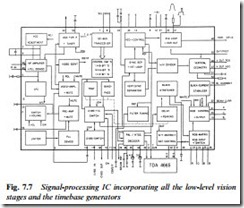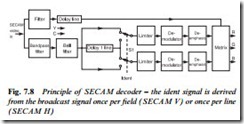SECAM COLOUR SYSTEM
An alternative method of colour encoding, used in France, USSR and elsewhere, involves a similar subcarrier system to NTSC and PAL, but here the colour-difference signals frequency-modulate the subcarrier whose centre frequency is 4.437 MHz. The R−Y and B−Y signals are sent sequentially, i.e. R−Y on line n and B−Y on line n + 1 etc. To identify which chroma line is which, special ident signals are transmitted during the field blanking period (original system: France, USSR, Luxembourg) or the line blanking period (Albania and the Middle East).
To decode SECAM signals the chrominance subcarrier is filtered out in a tuned trap centred on 4.437 MHz, then applied to a re-shaping (‘bell’) filter (see Fig. 7.8) to compensate for the characteristic of an opposite-law filter introduced at the transmitter
– their object is to improve chrominance S/N ratio. A pre-emphasis system is also used to the same end. The SECAM chroma signal now takes two paths – one direct and one via a one-line (64 μs) delay system. For any given TV line, then, both R-Y and B-Y signals will be available: one at the delay line output and one via the direct path. The double-pole, double-throw switch S1 is toggled at half-line rate 7.8 kHz) and steered by the SECAM-ident signal.
The now continuous R−Y and B−Y f.m. signals next pass through separate limiters on their way to f.m. demodulators, whose base- band output signals are then de-emphasised in the final noise reduc- tion process. As with NTSC and PAL colour-difference signals, they are now de-weighted and matrixed with the (delayed) Y signal to make up R, G and B signals for driving the display tube.
The advent of multistandard TV sets and videorecorders for direct reception of terrestrial SECAM transmitters, and particularly for use with satellite broadcasts, brought with it the need for SECAM signal handling even in countries whose own broadcast system is otherwise. Although videorecorders do not decode the chroma signal, their colour-under circuits vary with the encoding system in use, and in the particular case of Video 8 format machines, SECAM signals have to be transcoded to PAL before commitment to the tape, and recoded to SECAM during playback.
Where multistandard colour decoding is required there are several possible solutions. Fig. 7.9 shows one, designed for use with an IC like that shown in Fig. 7.7. This TDA8395 is a ‘supplementary’ chip,
providing SECAM decoding with a minimum of extra components: it uses the existing electronic delay line and reference oscillator, also the sandcastle gating pulse. Composite video enters at its pin 16, together with a stable reference frequency to its pin 1. Negative colour-difference signals emerge from its pins 9 and 10 to pass hrough the delay line (TDA 4665 in Fig. 7.7) for matrixing and control in the main IC.


